Maybe an Artist? An Interview with Liz Montague, Creator of the Graphic Memoir You Cannot Miss
I don’t truck with YA.
I respect it, mind you. It serves a vital purpose. But for years now I’ve drawn a sharp, delineated line in the sand between myself and the young adult book world. I don’t know if you know this but when I went in for my very first librarian job at the Jefferson Market Branch of New York Public Library I was handed a choice. I walked in the door and my new boss, Frank Collerius (whom you can hear regularly on the NYPL podcast The Librarian Is In) asked if I wanted to work in the YA space or the children’s space. I chose the children’s and never looked back.
But sometimes, gentle readers, I cross the line. I only do it when the book is extraordinary (and, let’s face it, usually a graphic memoir). Today, I do it for Liz Montague. Because she’s worth it.
ADVERTISEMENT
ADVERTISEMENT
As her publisher described Liz’s latest book, MAYBE AN ARTIST, A GRAPHIC MEMOIR to me:
When writer and illustrator Liz Montague was a senior in college, she wrote to the New Yorker, asking them why they didn’t publish more inclusive and diverse comics. The New Yorker wrote back asking if she could recommend anyone. She responded: “Yes. Me.” This made Liz one of the magazine’s first Black female cartoonists.
Those initial cartoons with the New Yorker led to MAYBE AN ARTIST, A GRAPHIC MEMOIR (Random House Studio |Ages: 12 and up |on sale October 18, 2022), a funny and poignant graphic memoir that chronicles Liz’s youth from the age of five through college. It showcases how she navigated life in her predominantly white New Jersey town, overcame severe dyslexia through art, and found the confidence to pursue her passion. Liz’s dynamic and accessible art style beautifully explores the age-old questions of “Who am I?” and “What do I want to be?” with pitch-perfect clarity and insight. Offering a fresh perspective on social issues like racism, sexism, and climate change. It also proves that you don’t need to be a dead white man to find success in art.
Folks, let’s have a word or two with Liz Montague herself:
Betsy Bird: Liz, thank you so much for speaking with me today. The book MAYBE AN ARTIST chronicles your journey making art from childhood on to adulthood. But what made you want to recreate your life as a book for young people? Where did this particular book come from?
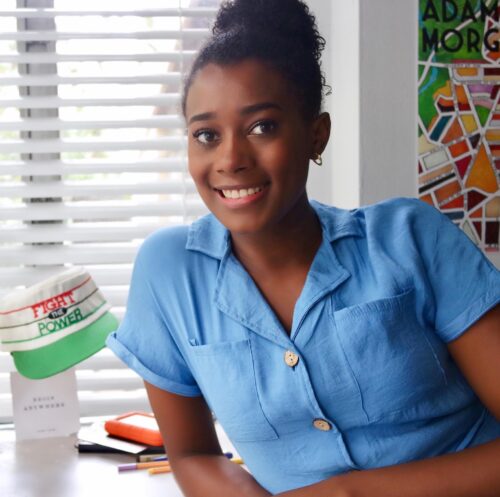
Liz Montague: Thank you so much for having me on the blog!!
When Annie, my editor, initially asked if I’d ever considered doing a graphic memoir, I was a bit shocked. At the time I was fresh out of college, living in D.C., and really had no idea what I was doing with my life or what I wanted to do with my life. I didn’t think I’d done anything yet that warranted a memoir. I was very hard on myself back then, I was working a 9-5 as a graphic designer and spending nights and weekends making cartoons for the New Yorker and Washington City Paper—but trust me, none of it felt aspirational. I was so stressed and burnt out, my workload was completely unsustainable, and I was working so hard but didn’t know what I was working towards, so I felt all over the place. I so clearly remember thinking, “I can’t be this miserable at 23, I have too much life left.”
With the book, I really wrote what I needed to hear. I oriented the narrative towards school and work and the expectations that come with all of that because I was trying to sort out my own relationship with it—especially now that I was on the other side of graduation. I’m not a person who really has regrets, but I wished I didn’t put so much pressure on myself. I had this desire to do life perfectly and make all the right choices and always have a plan and, when life inevitably wasn’t perfect, I would totally spiral. This book really came from me reminding myself that I didn’t ever really have the answers and, even when I thought I had a plan, things rarely went according to plan. There’s no way I could’ve micromanaged life to end up where I am, but I ended up exactly where I’m meant to be and I’m genuinely really happy.
Even with talking about the book, my shoulders relax, and my jaw unclenches and I picture myself in twenty years telling my current self, “it all works out eventually, just let go.” Which is basically the entire book in one sentence!
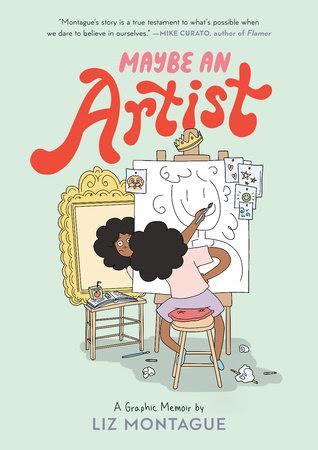
BB: When I first started reading MAYBE AN ARTIST, I was surprised that the book was being marketed as YA when the beginning feels very much for 9-12 year olds. Then, as Liz grows and matures and starts to question what it is that she wants out of life, I understood why this was maybe a more pertinent book for older readers. She has one particular line that stuck out for me when she says, “I never asked to be one of the five Black people in a rural suburb who now has to play a role, so I don’t make all the other Black people look bad.” How do you organize your life into a book that imposes a kind of narrative structure to a time that may not have felt structured to you as you were living it? Did you consult old journals or talk to people as you wrote this?
LM: I really wanted the voice of the book to age as it went and, especially for the beginning, I wanted the language to be super accessible. Emotional literacy can be a hard thing to communicate, and I didn’t want to rev the engine too early!
I did consult old journals, which aided in creating the voice. I’ve kept journals since I was in kindergarten and I still have all of them, which I’m grateful for. My husband, who I grew up with and went to middle and high school with, was a huge help too because he was there for all this stuff. And to be fair, as much as childhood feels like eons ago it really wasn’t that far away. Ten years ago, I was 16—which blows my mind!
Structure-wise, I used the evolution of my self-awareness to guide the book with school and eventually work as guideposts for that. I think that’s just how childhood goes in general; you’re super carefree and unaware, then you start becoming aware and immediately become self-aware. Then in addition to being self-aware, you’re aware of everyone else. It’s like our internal lens just keeps getting wider and the scope gets bigger and, with the new awareness and so much else to see, we have to work that much harder to get a sense of ourselves.
I’ve always been a pretty self-aware person, especially when I was younger, I was overly aware and invested in how I was perceived. Navigating perception, and whatever baggage comes with that is something a lot of people are thinking about and discussing right now, especially in terms of race, gender, and all the other external parts of being human. I put a lot of stock in how I thought I seemed. I think it’s a control thing, how anyone thinks of you is completely out of your control so, naturally, it’s what I wanted to control the most. But also, the very real reality is that people are interpreted differently based on race, gender, class, etc. It impacts life in a very major way. Navigating the relationship between who we are, internally, and how we seem, externally, was something I really wanted to talk about in the book. The intersection of self and social awareness is really the thread that connects all my work.
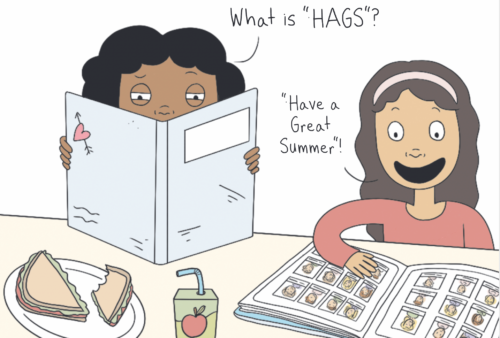
BB: So, we all know that some strides have been made in the publishing industry in terms of representation. But one area that is still, to this day, severely lacking is when it comes to graphic novel memoirs for young people. I can’t throw a dart without hitting twenty white women’s memoirs at once. There are slightly less written by white guys, but not a ton. And the rest of them? Let’s just say that I have a very hard time coming up with a single graphic novel memoir about/by a Black woman written for kids or teens. And I read a LOT. You’re entering a field that has, until now, been almost completely bereft of your voice. But then, you’re no stranger to that, having done work for The New Yorker as a cartoonist. What do you hope to do with this book? What would you like kids to take away from it?
LM: Luckily, nobody tells me this stuff until after what I’m doing is already done—I would’ve been so intimidated if I knew that before I started the book! Black women are unfortunately underrepresented in most fields and I’m glad that I can contribute to this one.
I’m really proud to be able to offer my perspective and some of my story. Right now, seems like a really overwhelming time to be a kid. There’s a lot of unprecedented stuff going on, but I hope my book shows you don’t have to be perfect or live during perfect times for things to work out. I know it’s super hard when you’re in the thick of it, but I hope I can encourage kids to stay in the thick of it and feel all the feelings. Tomorrow, next week, next year—it’s all going to come on its own, it doesn’t need your stress and anxiety to guide its way!
It all works out eventually, just let go. 🙂
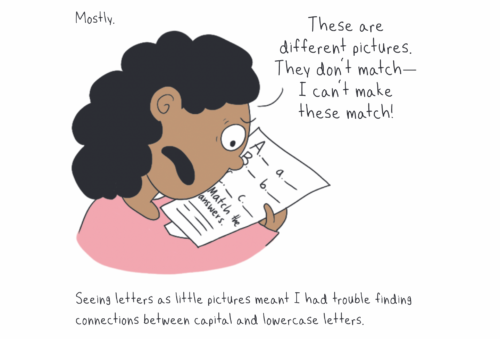
BB: Part of your narrative looks at your own struggles with dyslexia as a kid. Sometimes we see dyslexia represented in comics but not with any great consistency. How did you want to frame it, within the context of your own life? How did you make sense of it?
LM: I know it wouldn’t work for everyone but I’m glad my parents approached it as, “this is just the way you are, figure it out.” It wasn’t something to fix or be upset about, it was just something to adapt to. I’m grateful I never felt like there was something inherently wrong with me, it was just a matter of fact that I had to try harder to communicate with people, in both writing and speaking. I was so different from my sisters; I wrote backwards for seemingly no reason, I had a bad stammer, and I had a severe tongue-tie that I didn’t get surgery on until I was 17 which only made everything worse. It was a lot! I used to feel very underestimated. Because of how it all presented, I think the knee-jerk reaction towards me was, “well, at least she has sports.” Unfortunately, I think a lot of Black student-athletes deal with that.
In the book, I wanted to frame all of this as just the way I was, sometimes frustrating but not good or bad in and of itself and give what I hope are helpful tips that I used. Dyslexia was not fun when I needed to take tests, and it’s such a finite amount of time that you have to take tests in the grand scheme of things, but I probably wouldn’t have leaned so heavily into visual communication without it or learned how to make school fit me rather making myself fit school. The structure of education doesn’t fit everyone but even learning how to adapt within that structure, as someone who doesn’t fit it, was very valuable to me.
You have to make the brain you have work for you. Figuring out my brain and how to problem solve for myself gave me a lot of confidence. I never had a GPA high enough to get into the advanced English or AP Lit classes so I would reach out to the teachers and ask if, despite my grades, I could join their class. Sometimes I was for sure out of my depth, but I was happy to be there.
BB: Has the book been designed with dyslexic readers in mind (types of fonts, colors, spacing, etc.)?
LM: I wrote it with myself in mind if that counts! It hasn’t been tested or certified or anything though.
If a page is too busy it’s hard for me to concentrate and I end up reading the same three words over and over without processing any of it. I definitely have a preference for open compositions and like my hand held as far as how my eye is supposed to move on the page. I don’t automatically know where to look next and I really appreciate it when layouts feel like they’re working with me, not against me.
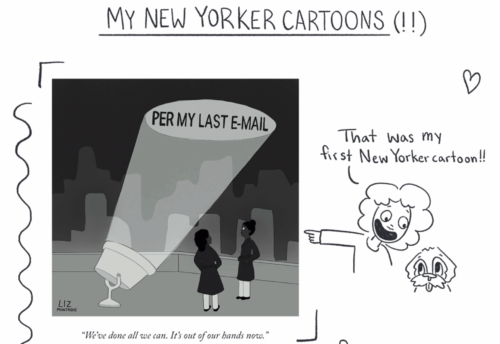
ADVERTISEMENT
ADVERTISEMENT
So, all of this went into my approach to the book! Really, it’s my approach to all my work. I want to communicate whatever it is I’m saying as accessibly as possible with the text and art working together as a team. And the font is actually my handwriting! I made it into a font for the book.
BB: Finally, what’s next for you? And what’s something you’d like to do in the future?
LM: I have four more books coming out so far, which is very exciting! The soonest one is a picture book about Jackie Ormes that’s coming in May, I’m really looking forward to that.
There’s lots I want to do. Somewhere down the road I’d like to try teaching, I want to grow more of my own food, learn how to snowboard, remember how to sew because I definitely learned in Girl Scouts but have completely forgotten, and a bunch of other cool stuff that hasn’t been revealed to me yet!
I want to thank Liz Montague for taking the time to answer my questions today. Thanks too to Cynthia Lliguichuzhca and the folks at Random House Children’s Books for setting up this interview today. Liz’s book MAYBE AN ARTIST is out October 18th on library and bookstore shelves everywhere. Be sure to check it out!
Filed under: Interviews
About Betsy Bird
Betsy Bird is currently the Collection Development Manager of the Evanston Public Library system and a former Materials Specialist for New York Public Library. She has served on Newbery, written for Horn Book, and has done other lovely little things that she'd love to tell you about but that she's sure you'd find more interesting to hear of in person. Her opinions are her own and do not reflect those of EPL, SLJ, or any of the other acronyms you might be able to name. Follow her on Twitter: @fuseeight.
ADVERTISEMENT
ADVERTISEMENT
SLJ Blog Network
Name That LEGO Book Cover! (#53)
K is in Trouble | Review
Fighting Public School Book Bans with the Civil Rights Act
Take Five: Middle Grade Anthologies and Short Story Collections
ADVERTISEMENT







